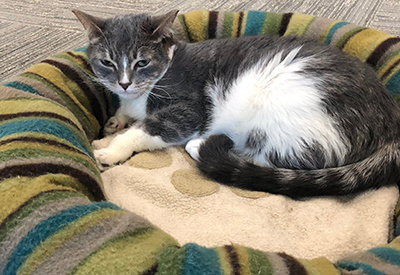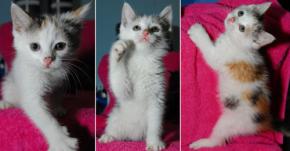Diabetes: Pets and People

Diabetes: Pets and People
November is American Diabetes Month. To highlight how veterinarians care for pets with diabetes, I thought I would tell the story of one of my patients, a fluffy, grey and white cat named Stone.
Stone is a youngster, just under two years of age. He came to see me because his owner had noticed weight loss and excessive drinking. Weight loss and excessive drinking are common clinical signs of diabetes, but Stone was much younger than the typical cat with diabetes. Hyperthyroidism can also cause weight loss and increased drinking, but typically occurs in older cats.
Another cause of weight loss and excessive drinking is chronic kidney disease, but again, typically in older cats. I wasn’t really sure what was wrong with Stone until the blood tests showed sugar in his urine and an elevated blood sugar.
Dogs and cats have different forms of diabetes. Dogs commonly have Type I diabetes, which is a total lack of insulin production by the pancreas. Cats have Type II diabetes which occurs most commonly in middle to older overweight cats. Unlike humans with Type II diabetes, cats require insulin injections where humans can often manage Type II diabetes with oral medications and diet. Strangely, with weight loss, insulin therapy, and a special diet, some diabetic cats will become normoglycemic again and no longer require insulin. This happened to my own cat and he stopped needing insulin for a year. Then became permanently diabetic and required insulin for the rest of his life. I think chronic inflammation of the pancreas (known as pancreatitis) was the likely cause of the diabetes.
Stone was in to see me just a few days ago. On twice daily insulin therapy, he has gained back some of the weight he lost and is eating his special diabetes diet with gusto. Blood tests indicate his blood sugar is well controlled and his owner notes it is getting harder for her to test his urine to measure the urine sugar level. I am suspicious he may be heading for a period of diabetic remission.
To help my readers understand the similarities between their own diabetes and that of their pets, I included a table below with a comparison of the common features of the disease.
Comparison of diabetes between people and their pets:
| Cat | Dog | Human | |
| Occurrence | 0.58% of cats | 0.35% of dogs | 9.4% of Americans |
| Type I diabetes | No | Yes | Yes |
| Type II diabetes | Yes | No | More than 90% of diabetes |
| Diabetic retinopathy | No | Rare | Yes |
| Diabetic nephropathy | No | No | Yes |
| Association with pancreatitis | Yes | Yes | No |
| Oral treatments | No | No | Yes |
| Insulin injections | Yes | Yes | Yes |
| Spontaneous remission resolution | Yes | No | No |
| Diabetic cataracts | Rare | Yes | Yes |
| Linked to obesity | Yes | Yes | Yes |

































